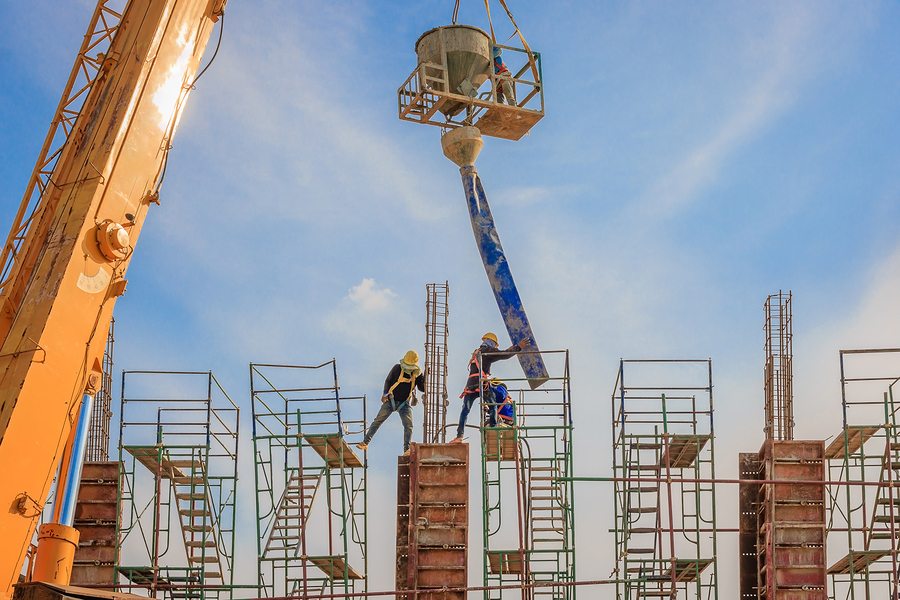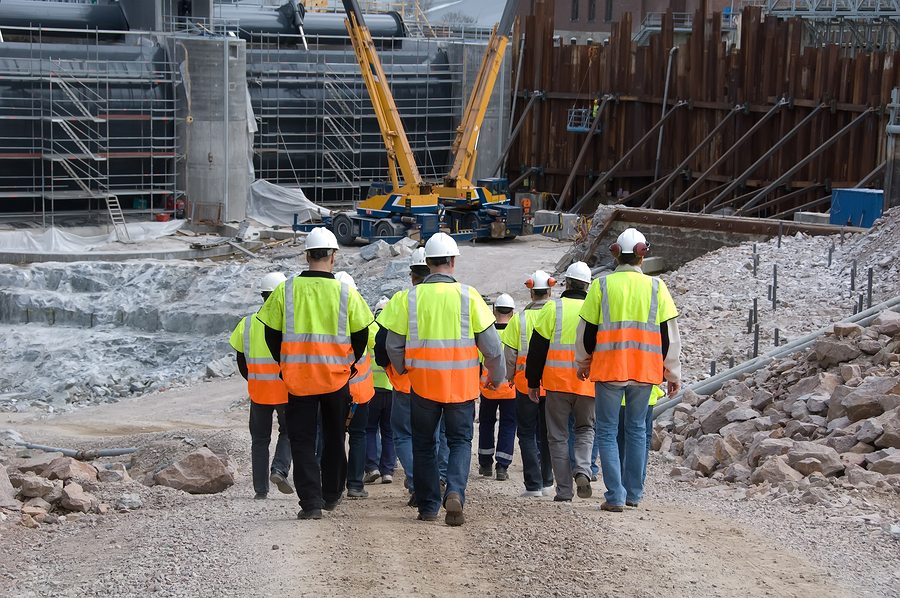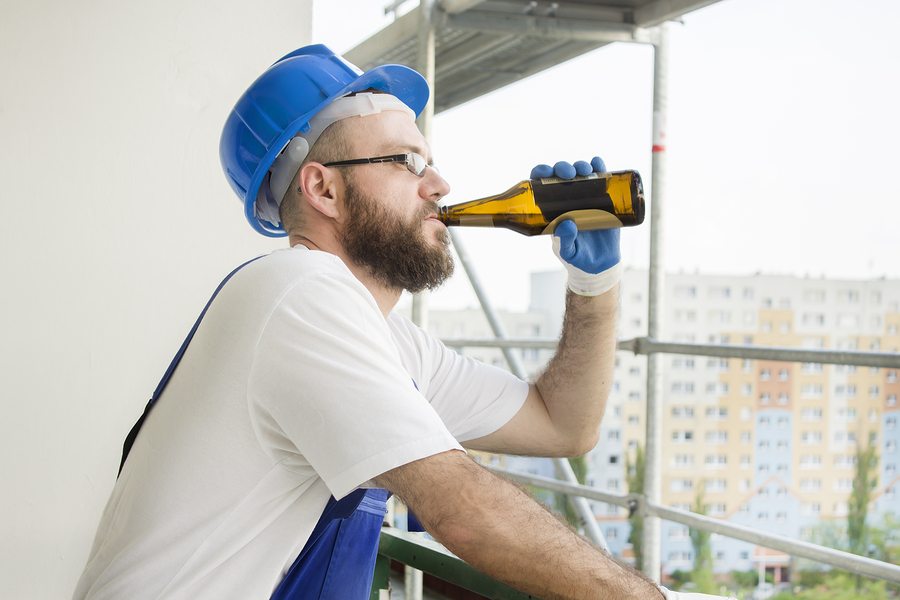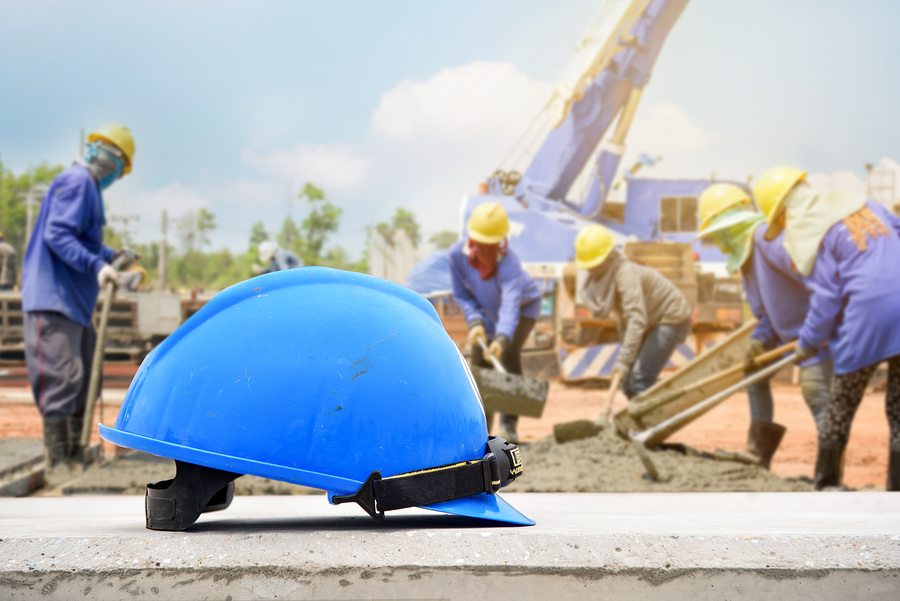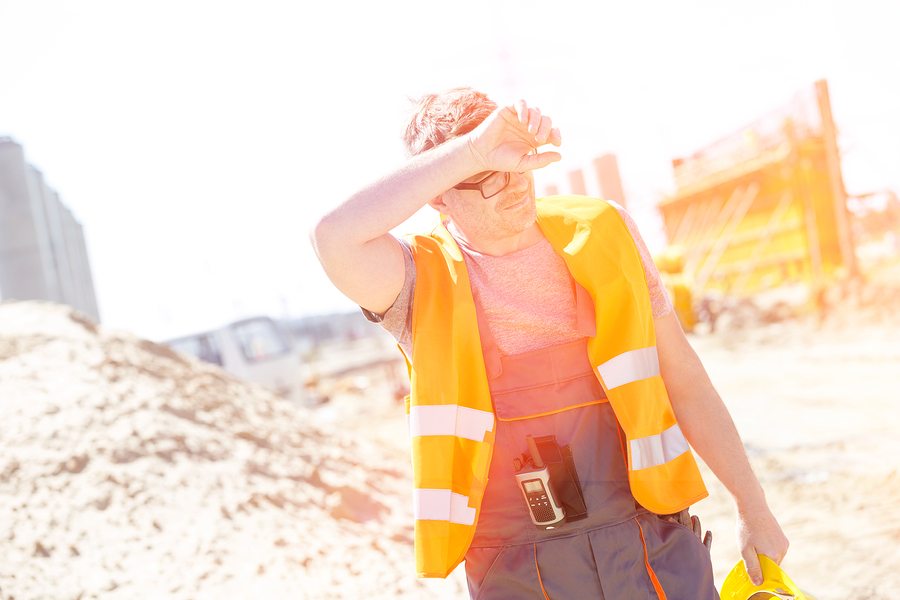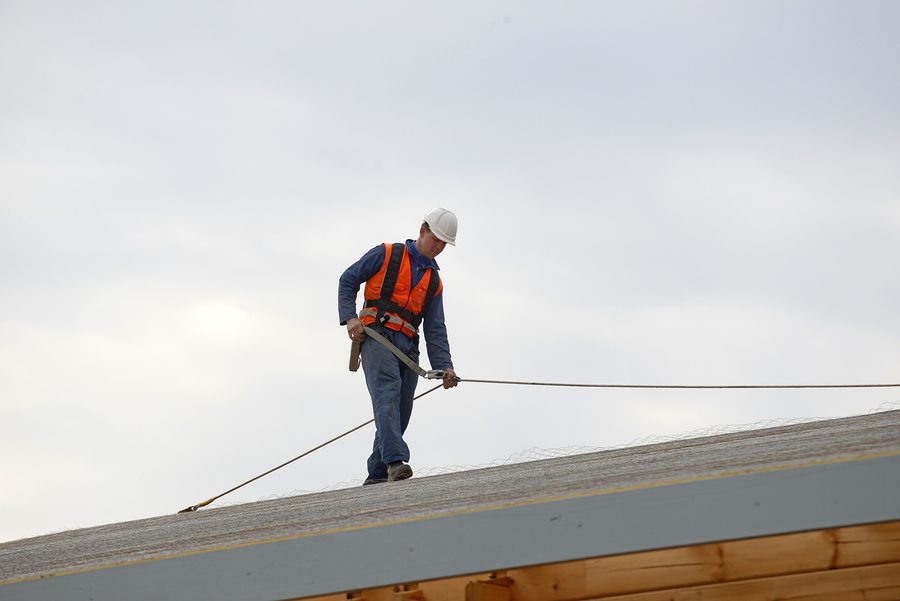by jeffp | Oct 11, 2017 | Construction, Uncategorized

Construction sites are active environments. Active transfer of people and materials creates the potential for anything to happen. Site safety is a regulated industry. Safety standards and guidelines in place by OSHA and the International Code Council help maintain site and worker safety
These agencies recommend safety measures developed following years of real-world learning. In the early 1990’s, builders discovered gaps in standardized building safety ordinances. By 1997, the ICC published the first international safety guidelines: the International Building Code (IBC). Alongside OSHA, these agencies set the standard for construction site safety measures.
ICC and OSHA regularly publish standards recommending guardrails on construction sites, keeping workers safe. These safety standards help keep workers safe and reduce insurance costs:
1. Guardrails for Construction Sites
Guardrails help prevent falls on construction sites for workers and visitors. Builders can seal-off areas and secure open walkways for safety. Construction guardrails are for securing:
- Platforms
- Stairs
- Rooftops
- Pits
- Wells
- Materials
Guardrails are required anywhere 30 inches or more separate two walking surfaces. Per ICC and OSHA regulations, rails are to be constructed of rigid materials built to a height of 42 inches above the platform. OSHA regulations stipulate areas separated by 6′ of difference or more be equipped with guardrails or fall-protection system.
2. Construction Site Guardrail Installation
Site guardrails are subject to OSHA and ICC guidelines on proper construction. Regulations for guardrail construction protect workers and visitors. Builders employing properly constructed guardrails:
- Keep workers safe on constitutions sites
- Keep visitors and passerby safe
- Keep access limited to authorized persons
- Keep insurance rates low
- Keep building costs low
- Keep construction companies operationally compliant
Properly constructed guardrails built to code limit builder insurance and legal obligations. This translates to saved time and reduced costs for construction companies and builders alike. Load requirements are determined by architectural design. The forces and stress-levels specific to a site determine guardrail load limits.
3. Guardrail Load Requirements
OSHA and the ICC set guardrail load requirements for the construction industry. Load requirements may vary due to the site and architectural layout. Construction site guard rail general load limit guidelines express rails be able to support:
- 50lbs of weight per foot
- 200lbs of direct force, anywhere rails are present
Rails may shift during building, and wear-and-tear is a part of guardrail construction. Regular inspection of guard rails by site managers and safety personnel helps keep rails safe and compliant.
4. Staying Compliant
Construction companies and builders following the guidelines in place by OSHA and the ICC will avoid penalties and fines. Local authorities enforce construction site safety. Each governing body has authority to issue fines and other reprimands for non-compliance. Repeat violations result in increased severity of penalties. Fines may reach as high as $100,000 per violation.
Construction companies also have the moral obligation to workers for creating a safe work environment. Builders work on reputation, among other traits. Companies holding positive reputations and safe track-records are much more likely to secure bids and contracts. Safe employees can perform better knowing the site is safer, keeping building and insurance costs low.
Construction and insurance topics directly affect health and pocketbook. Topic suggestions are always welcome. Contact an agent for any insurance-related questions or for an insurance quote.
by jeffp | Sep 27, 2017 | Construction

Building and construction managers know the importance of an effective workforce. In the trades, time is money. Businesses that want success must use every resource available to maximize workforce potential. At the same time, poor management increases risk, adding to insurance costs. Effective management will help grow your business, reduce overhead, and maximize employee output. Reduce risk and increase productivity. These four methods help construction managers improve building and construction management:
1. Create Effective Processes
Information is accessible like never before. With modern technologies, you have access to real-time stats and information. Effective managers act on this information creating safe and productive work environments. Acting on this information, effective managers create documented workflow processes.
Your processes should define the safest and most-effective method for completing the work. Processes have the dual benefit of increasing productivity while reducing risk, altogether reducing overhead. Ideal workflow processes should be user-friendly and easy to use. Processes should increase your productivity – choose processes that make sense for you, and for your business.
2. Go Digital
Even small building and construction businesses have a lot to juggle. Each construction project requires hours of administrative support. Planning, resource management, people management, billing and more require dedicated time and effort. Huge companies have the benefit of billing and sales departments – then there’s everyone else.
Today, innumerable mobile and desktop solutions exist helping builders spend more time focusing on the work. Digital invoicing, resource tools, and client management ensure paperwork is never lost and projects finish on time. Move your business into the digital space and increase your productivity.
3. Maximize the Workday
Projects are expensive – time wasted is money wasted. That’s why it’s all the more shocking many construction employees spend up to 50% of the day waiting for work to begin. Improve time management on the job site and you’ll almost-automatically increase workforce productivity.
You don’t need to hire an outside consultant. A glance at your how your employees spend their time can show ways for increasing efficiency. Look for ways to reduce time spent on:
- Workday planning
- On-site travel
- Material procurement
- Tool unloading
- Site preparation
- Site cleanup, and more
As with processes, streamlining job-site activity reduces chances for mishap due to employee error.
4. Communicate!
Communication is the cornerstone of an effective workplace. Construction and building managers can use the following communication strategies for improving workplace efficiency:
- Encourage collaboration. Employees should feel comfortable sharing ideas with each other. Different perspectives may offer new solutions not yet considered.
- Communicate clearly. Be clear about tasks, goals, and processes with employees. Construction employees should know their roles and accompanying expectations. Employees should know established processes for the job site and projects.
- Encourage feedback. Your employees are at the ground-level, so to speak. On the job site, they may notice a process in need of improvement, or an unsafe condition. Employees should feel comfortable communicating with management about workplace safety and efficiency.
Decrease risk and increase reward. Healthy communication on the job site can help avoid costly mistakes and reduce employee risk.
Increase Jobsite Productivity Today
The benefits are clear. Adopting effective management techniques pays dividends for production and reduces workplace risk. Strong construction and building managers enjoy the benefits of:
- Reaching Goals. Achieving workplace goals on-time speaks volumes about your job site and resource management. Complete more jobs per year with sound management.
- Managing Expenses. Every business – no matter the size – must focus on accounting. The better you manage your expenses, the more profit you stand to gain.
- Reducing Downtime. If employees spend 50% of their day waiting to work, you could be completing twice as many projects. Manage employee downtime effectively to maximize productivity and revenue.
- Improving Industry Reputation. Better management means better work. Better work means a better reputation. Word travels fast – clients will find you based on the reputation you build based on effective management.
We welcome information on insurance topics that affect your quality of life. If you have any questions about insurance call us for the answers!
by jeffp | Sep 22, 2017 | Construction

Construction sites might not be as safe as you think! A recent Substance Abuse and Mental Wellness Services Management survey found the building and construction industry ranks high for substance abuse. The building and construction trades ranked second-highest for substance abuse disorder. This accounts for an incredible 14.3% of construction employees between 16-64. Construction workers also ranked second-highest for alcohol abuse. Although well-intended, the 25-year-old Drug-Free Workplace Act has failed as of late.
Today, Substance Abuse Disorders (SUDs) are causing increased safety and security concerns on the job site. Recreational legalization of Marijuana in many states contributes to on-site usage. Ready access to opioids and fentanyl increase risk of incident. Most businesses use drug screening but many do not continue after hiring.
Tom Jackson wrote a two-part story about this phenomenon in Tools World. He claims in the building sector it was common for 25-35% of pre-employment drug tests to ‘fail’, according to IMRI insurance and risk management. Even when employees know they’re going to undergo a drug test, 3-5% still test positive for drug use.
Jackson included prescription medications in his concerns. The Department of Labor states alcohol and drug abuse causes up to 65% of on-the-job accidents. Additionally, alcohol and drugs are responsible for up to 50% of work-comp claims. Employees abusing illegal substances are absent from work an average five days per month. They are 10 times more likely to steal from the company or other workers, use three times the average wellness advantages, and devour 300% the average medical costs.
Drug use isn’t the only concern. A 2014 investigative report in Devices Globe followed a WABC television team based out of New York City. They found a team of building and construction employees drinking during lunch breaks. This occurred at four different locations, on three separate occasions. Some workers observed were responsible for running cranes and other heavy machinery. Industry response was immediate. The construction company fired several of the employees. Across the industry, officials demand mandatory alcohol testing.
President Trump and Attorney General Sessions have declared war on opioid use in the United States. Janet Yellen, Chair of the Board of Governors of the Federal Reserve System, testified before the US Senate Financial Committee. She worries about the rise in opioid deaths in the US, a developed nation, particularly among less-educated men. On opioid use, Fast Company recently released an article focusing on a powerful new drug: Fentanyl. The article demonstrated the damage Fentanyl causes across the United States even now.
Some may think that it’s too little and too late for the building and construction sectors. While we don’t agree, we think it’s time to address the safety concerns dedicated managers want. Stay ahead of substance abuse issues in the workplace to avoid liability and safety issues.
We are constantly on the lookout for information to better your health and your wealth. If you have any insurance-related questions contact us today.
by jeffp | Sep 16, 2017 | Construction

Hard hats have long been a staple safety item for the construction industry. For years, builders and tradespeople have relied on traditional construction hard hats to keep them safe – but things are changing. Bloomberg BNA recently released a report highlighting an increased interest in new, high-tech construction safety gear. More construction companies are switching to helmets of a new design, reducing the risk of workplace injury. These helmets protect employees from dropped objects, flying debris, and offer protection from falls. These types of accidents are the chief causes of traumatic brain injuries (TBI) among construction employees.
A report based on government data uncovered over 2,200 cases of TBI among workers in the building and construction industries between 2003 and 2010. For every 100,000 construction employees, 2.6 would die from a workplace accident. Most injuries were a result of dropped items or materials. Workers aged 65 and above suffered the highest risk for injury. Employees in working in steel and iron reported a higher number of TBI cases.
The new construction helmets (called ‘headgear’ by the wearers) have an advanced design. The design includes suspension bands within in the helmet, creating about an inch of space between the wearer’s head and the hard surface. These features serve a dual purpose:
- Cushion the impact of a fall from a height
- Absorb the effect of any object that might hit or fall on the worker’s head.
Helmet weight is evenly distributed across the wearer’s head making the headgear more comfortable and offering more protection against impacts on the head.
According to the Bloomberg report, the inspiration for the design came from equipment used in mountain climbing. Mountain climbing is very dangerous, and climbers need serious protection. Their helmets offer protection against accidents, falling rocks, and long falls. Construction companies find this design translates very well for building industry safety.
The idea to equip builders and construction workers with better safety equipment is not new. Employee safety and protection is the priority of the National Institute for Occupational Safety (NIOSH) and has been since the 1970s. Since then, the NIOSH has conducted many studies on helmet safety. NIOSH engineer Christopher Pan noted in a report that safer helmets are a major concern for all building trades. Pan stated it was time safety features rooted in science, physics, and medicine influence helmet design. to the helmet. Pan’s concerns are for the employee, he believes construction workers have a right to safe equipment. He challenges regulators and safety advocates to demand the new headgear, forcing companies to follow suit.
The law is on the side of the employee. The Occupational Safety and Health Administration (OSHA) regulates safety equipment enforcement. Construction sites are dangerous. Employees on the job site risk falling and flying objects, falls, impacts, burns and more. OSHA requires these employees wear safe and secure helmets for their protection. Their helmet MUST meet or surpass the standards set by the American National Criteria Institute.
We always keep a lookout for great information about insurance topics that can influence your health, and your pocketbook. If you have any insurance related questions, please be sure to contact us.
by jeffp | Aug 30, 2017 | Construction

During the hot summer months, construction moves into overdrive. Workers in this industry are grateful for the work… and may be quietly struggling with the heat.
If they’re not careful in hot weather, construction workers can suffer dehydration, muscle pain, and heat stroke. That’s for starters.
To help out, here are some tips by Mike Flynn a health and safety expert…
- Flynn stated that construction employees need to be trained to look for signs and symptoms of overheating. The most common symptoms include paleness, unsteadiness, and excessive sweating.
- Heat can also cause workers to shed their protective gear which can be dangerous when working in construction or next to traffic. Workers need opportunities to remain hydrated and extra monitoring to ensure proper safety protocols are followed…
- Workers may also lose concentration while on the job due to the high heat conditions. Flynn noted this and strongly advises construction company owners and managers to be as sympathetic as possible to outdoor workers.
For employees who have not been trained on staying safe in extreme weather conditions, Flynn encouraged folks to download the OSHA Heat Safety App so that they could come to work better prepared. (Check it out here: https://www.osha.gov/heat/)
This application lists the daily heat index and also has precautions that people should take in order to stay safe when outside.
In addition the resources offered by OSHA, it’s also a good idea to start the work day as early as possible. This will reduce the amount of time spent working outside at the hottest part of the day. Additionally, make sure to drink water constantly throughout the day and wear a wide-brimmed hat in order to limit the amount of direct UV exposure.
For other risk management thoughts to help keep your worker’s comp rates as low as possible, be sure to reach out to us. We love to help!
by jeffp | Jul 28, 2017 | Construction

Envision this situation: A building employee is changing shingles on the roof covering of a two-story house 20 feet over ground. He loses his ground as well as slides, diminishing the roof covering. He’s using a fall-arrest system, and also consequently is saved from fatality.
Yet he’s not unharmed yet.
This worker can potentially experience orthostatic intolerance– additionally typically described as suspension trauma.
Just what is it?
OSHA explains suspension injury as “the advancement of signs and symptoms such as light-headedness, bad concentration, palpitations, tremulousness, exhaustion, nausea or vomiting, wooziness, frustration, sweating, weakness and periodically fainting during upright standing.”
After a fall, an employee might remain suspended in his or her harness prior to being saved. Depending upon the length of time the employee stays suspended, the continual stability could lead to unfamiliarity and even death. This is because of “venous pooling,” a problem that takes place when a person’s legs are stable as well as blood swimming pools in the legs, decreasing the amount of blood distributing in the body.
OSHA keeps in mind that the body reacts to venous pooling by quickening the heart price in an attempt to keep adequate blood circulation to the brain. If a person’s blood supply is considerably minimized, this won’t be effective as well as the body will after that “suddenly slow down the heart rate and also blood pressure will diminish in the arteries.” In severe situations of venous merging, an individual could faint or experience kidney failure, which can be fatal.
Move fast
Speed is crucial after an employee experiences a loss. Suspension in a fall-arrest tool can lead to unconsciousness and also death in less than 30 minutes. Inning accordance with OSHA, workers who use fall-arrest tools or that might execute rescue activities must recognize:
Ways to determine whether their personal protective tools is appropriately used and fitted
Just how suspension injury might happen, along with its signs and symptoms
How you can use suitable rescue treatments and techniques to reduce threat while put on hold

